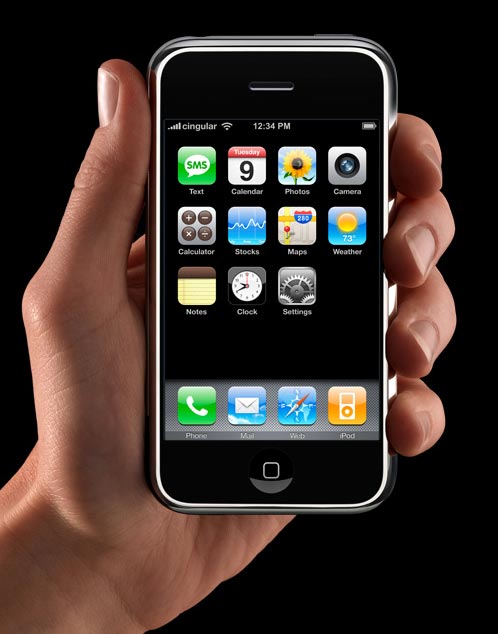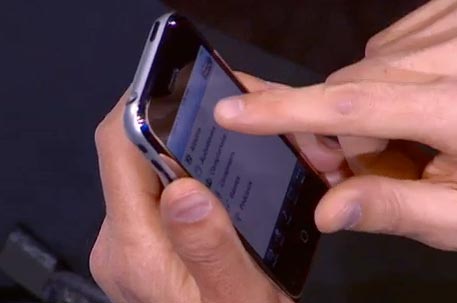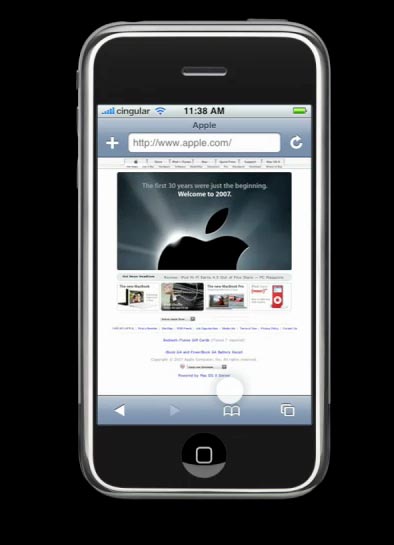CES 2007 - Part II: IPTV on Xbox 360, iPhone and DTX
by Anand Lal Shimpi & Manveer Wasson on January 16, 2007 12:00 AM EST- Posted in
- Trade Shows
Apple’s iPhone
For a while there I’d get just about every Pocket PC that was released with the hope that I’d actually use the new device. Even after the switch to Windows Mobile, the I found myself with a bunch of PDAs that I used only for a short while before the cool-factor wore off and the fact that they weren’t very useful just settled in.
You’d think that over the past decade cellphone makers would be able to perfect these devices that have so ultimately penetrated our lives. In many senses they have, but the one area that has gotten more cluttered than perfected has been in the user interface department. Cell phone UIs are basically an exercise in choosing between the lesser of two evils; of all of the great user interfaces developed in the PC technology era, cell phones are no where near the top of that list.
Smart phones are a bit better, but for the most part they have been victim of poorly scaled down interfaces of their desktop counterparts. What technologies like Intel’s Centrino and Microsoft’s Media Center Edition have taught us is that to truly build a successful product in a particular market, you have to tailor it to that market, you can’t simply use a scaled down version of a product aimed at a different segment and expect it to be perfect.

It’s in the UI that Apple’s iPhone is the most revolutionary, at least upon first glance. Those users who have pointed out that there’s nothing truly new about the iPhone are right; fundamentally most of the features of Apple’s iPhone can be found in other phones, but it’s in how those features that are implemented that set the iPhone apart from its competition.
At first glance the iPhone doesn’t look all that impressive, but in the usage videos at Apple’s site and during the Jobs keynote you really get insight into the strengths of the UI. Its speed, simplicity and organization of things like text messages and voicemails just makes sense, to the point where we wondered why it hadn’t been done before. Obviously there are a lot of unanswered questions about actual usage of the phone and the multi-touch screen, but what we’ve seen initially looks promising. If the iPhone ends up being a failure once you have the device in your hands, at least what we’ve seen from its UI can serve as a blueprint for future smartphone makers of directions to explore.


There will obviously be drawbacks to the iPhone, even the initial demo at Macworld wasn't without flaws. Touch typing will be difficult on a device that provides no tactile feedback, web page rendering speed during Steve's keynote wasn't exactly fast, and neither is Cingular's EDGE network that the device will operate on.

What about cost? Apple has built its business around selling products that command a premium over competitors that fundamentally have a product that has similar functionality. At $499 and $599, the iPhone may be unreasonable for most, but Apple has never built products for the majority of the market. Its pricing won’t lead to failure, but it will not overtake Motorola, Nokia and Sony Ericsson as the leaders in the cell phone market. Don’t expect the iPhone to take significant marketshare away from RIM and its Blackberry devices, although it could significantly hamper RIM’s efforts to bring Blackberry to consumers rather than just enterprise customers.

There are entirely too many enterprise features of Blackberry for the iPhone to offer true competition to it, but for consumer users who RIM hopes to convert with phones like the Blackberry Pearl, the iPhone may be tough competition. In fact, all smartphones in the iPhone’s price range are now at risk of some fierce competition by Apple’s offering. The reason being that a huge population of smartphone customers use their phones for one or more of the features that Apple included in the iPhone: email, web browsing, text messaging and voice. Being able to install your own applications would be nice but it’s not necessarily the type of functionality Apple is targeting with the iPhone; perfection enabled through simplicity is Apple’s game here. It aims to perfect some of the fundamental functions of smartphones and then worry about additional functionality at a later time. Part of the problem with the evolution of cell and smartphone UIs is that so much functionality kept on being added without ever perfecting the interface at any step in the game, leading to devices that can do just about anything at all, but nothing well.

In the world of convergence devices, the iPhone doesn’t actually win Apple any more ground, but it has the potential to truly revolutionize one more gadget we use on a regular basis. If not through the iPhone itself, through the many competitors to it that will undoubtedly rise over the coming years; just look at the effort Microsoft has put into Zune as a result of the iPod. Even if it isn’t met with a tremendous amount of success, whether or not you end up with an iPhone in your pocket the consumer stands to benefit tremendously.










15 Comments
View All Comments
Rock Hydra - Wednesday, January 17, 2007 - link
I hope not.
archcommus - Tuesday, January 16, 2007 - link
The article speaks largely about waiting for a company to do convergence perfectly, to combine the PC and TV seamlessly and easily. Am I missing something here or can I do this all on my own very easily? I don't own my own home, but if I did, I would have a server PC with all of my content, PCs in each room, a PC powering each TV (or monitor, same difference really), with gigabit ethernet connecting it all. Each PC powering a TV would of course have a tuner card installed and PVR software like SageTV. Bingo - every TV in my house can now watch live TV, function as a PVR/TiVo-like device, and also view content stored on any PC in my home since they're all on one LAN. I can also play my music, view my photos, and even browse the internet if I wanted at any TV in the house.There. Did I just solve the problem? :P I'm kidding of course, I just don't get what I'm missing here.
Wellsoul2 - Thursday, January 18, 2007 - link
IPTV-But you've got to pay..same old same old.Right now my cable is connected to my computer and I get over the air HDTV.
My computer does DVR..all this with a cheap tuner card.
Seems pretty lame to use an XBOX when you have a PC that can adjust the
picture etc and play videos from Yahoo already.
My TV is my second monitor already.
Itunes downloaded stuff is ok for tv shows..movies are pricy.
Araemo - Tuesday, January 16, 2007 - link
"The real question is whether or not AMD will be able to put enough resources behind DTX to make it a widely accepted industry standard."You know, they really might not have to. Why? Same reason ATX actually caught on: Cases can be built VERY EASILY to support both DTX and ATX, or Mini-ITX and DTX.. allowing case manufacturers to hop on board for almost no cost.
Motherboard manufacturers don't even have to wait for the cases to be available, since the DTX boards will fit on ATX cases... So I'd expect, if AMD doesn't piss anyone off, and makes nice with ASUS and the other tier-1 mobo manufacturers... smaller DTX boards might replace mini-ATX if they have any significant improvements. (What I'm trying to say is: What is the risk if ASUS makes their tiny board with only one PCI slot DTX or mini-ATX? There should be none, if the board was already designed to be that cheap and restricted for low costs... The board will still work in ATX cases so they can advertise it as dual compatibility.)
RogueSpear - Tuesday, January 16, 2007 - link
I DVR just about everything that I watch. With the amount of money I throw at Time Warner I feel justified in blowing past all of the commercials, plus I like to watch things when it's convenient to me. So can I keep on playing a game at full speed (or for that matter at all) while this thing is recording one or two HD streams? Or do I need to put the controller down because it's time to record The Office?glennpratt - Tuesday, January 16, 2007 - link
Divx != Pirated; and vise versa Anand. I get the point, but that mentality doesn't help.If only it were easy to encode every movie and TV show I own or have recorded to a decent format and have everybody play it. But no! Movie companies want to throw a wrench in the works and software developers want to divide up the broken works into sovereign territories.
PrinceGaz - Tuesday, January 16, 2007 - link
In fact these days most pirated content is encoded with XviD rather than DivX. Admittedly there isn't really much difference between them as they are both implementations of MPEG4 ASP, and on a computer you can play back DivX encoded files using the XviD decoder and vice-versa.mino - Tuesday, January 16, 2007 - link
Well, for the most part, I do NOT play the movies I bought! I just encode the to some high-quality XviD, put on home NAS and then play whenever I want (without all of the commercials and other things I paid for while not eanting them).AFAIK most friend do it this way so I really see no reason for going DRM...
However that DTX thingie seems sweet. Especially combined with Fusion...
Goty - Tuesday, January 16, 2007 - link
If you look at the placement of the northbridge relative to the memory slots (find pictures elsewhere on the web for a full shot of the board), the CPU socket sits right between the two. What does this mean? This means that there's pretty much no way that this form factor will work with any CPU that doesn't utilize and onboard memory controller, i.e. this pretty much leaves Intel out of it.Araemo - Tuesday, January 16, 2007 - link
Besides the fact that you can probably relocate both mobo and northbridge if your northbridge is your memory controller - Intel is moving to an on-die memory controller too, so that is fairly forward-thinking.